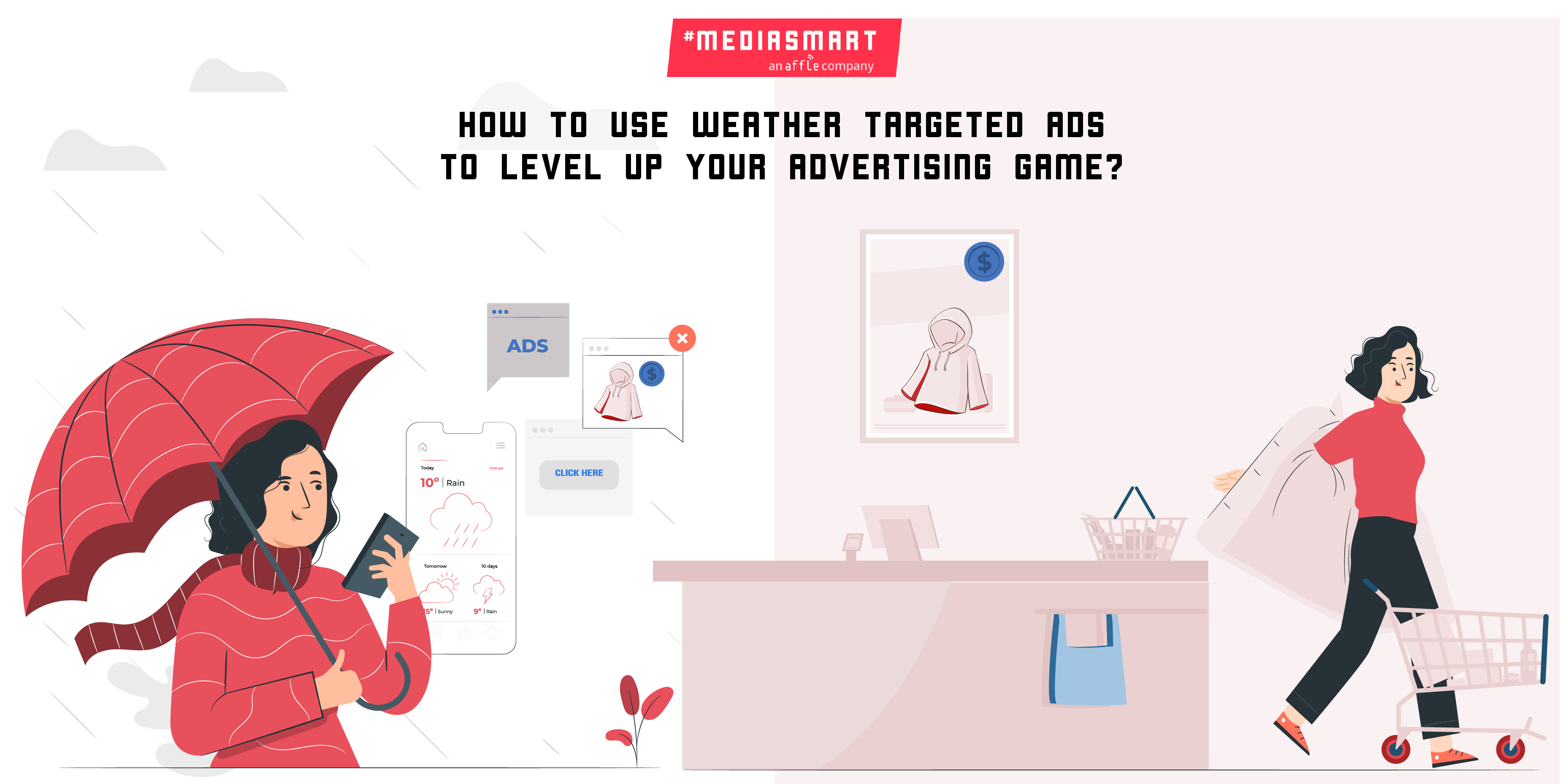Blog
Announcements, analysis and opinions on industry trends around the mobile programmatic world.

Subscribe now, and receive the latest programmatic content directly on your inbox!
Thank you for subscribing to our newsletter
"Oh no, I can't go to the grocery store now"
"Why? What happened?"
"It is raining outside and I don't have a raincoat"
"No worries, we will wait for the rain to stop. In the meantime let's watch something on Tv"
This situation might sound familiar. You might think that the supermarket owner and the raincoat retailer have a potential customer they can't reach at the right moment and at the right time. On the contrary, instead of losing a potential customer, they can gain one and take advantage of the situation. Let's elaborate.
You are a raincoat retailer, and you've got a potential customer in need of a raincoat, sitting at home watching TV, waiting for the rain to pass. The best time to advertise would be during this rainy weather, as consumers are less likely to buy a raincoat on a sunny day.
You could impact them with ads on both their CTV and smartphones while they are at home. Showcasing your brand and a selling proposition on their CTV and then showing a rich media ad on their smartphone including either a discount for the raincoat or a map redirecting them to your nearest store.
So, what’s happening here?
We are advertising raincoats during weather-specific conditions. Your ads are weather responsive, which means there is a higher chance of users purchasing from your store, either e-commerce or a physical one. We are increasing store footfall, optimizing ad campaigns through CTV and mobile ads, and targeting a user when there is a need to buy your product. All at once.
Now, take the other scenario. Because it is raining, this potential customer doesn’t want to go out but needs to buy groceries. What if a supermarket owner from the nearby area, shows an ad talking about their doorstep delivery, available 24*7? It’s a done deal!
The store is likely to experience higher website traffic, conversion rate and acquire new users at a faster pace.
These are some of the many occasions where weather targeted ads level up the advertising game.
Weather targeting – Real-time weather triggers to drive sales
Weather affects consumer moods, purchase methods and product choices, and should be considered while advertising.
Any campaign running in mediasmart can use either Peer39’s weather contexts or our own weather conditions solution to target specific weather. We will not only automatically measure performance across weather conditions but allow you to build dynamic creatives and maximize engagement or conversion rates based on them.
Weather targeting has become a mainstream component to note while advertising these days. Accurate data in real-time will ensure the targeting of behavioural audiences better. Knowing weather conditions will also predict consumer behaviour that depends on weather signals.
Use Cases: Use Weather in real-time for Targeting your Mobile and CTV Ads
A travel company's ads changing destinations depending on the weather is an obvious example to explain the relevancy of dynamic creatives that change with climate conditions. But there are many instances where the weather could play a major role in Advertising.
Below listed are some of the weather options available on mediasmart with examples of cases that could use those conditions to optimize ad campaigns:
- Clear - Sunglasses, Cold beverages
- Overcast clouds - Cab facilities, Beach trip
- Fog - Warm clothes, Cosmetics
- Few clouds - Raincoats, Indoor games
- Scattered clouds - Clothes, Footwear
- Broken clouds - Wellies, Umbrella
- Smoke - Air purifiers, Masks
- Rain - Home deliveries, Waterproof products
- Snow - Warm clothes, Skiing trips
Weather conditions could also be suppressed. People will be less likely to go out in pouring rain, so a drive-to-store campaign whose aim is to drive footfall to stores in the physical world would underperform in bad weather. An advertiser can minimize investment when it is raining, thus, maximising advertising budgets.
How can weather conditions help your campaigns to deliver these outcomes?
Brands can leverage the knowledge of weather to deliver weather-activated campaigns and correlate this with the season to identify best selling products.
There are three main ways targeting weather conditions can help maximize your budgets: serving more relevant ads, maximizing the reach and accelerating the conversion rate.
- Serve more relevant ads
User interest can be linked to the product recommendation displayed on various pages allowing brands to customize their offerings based on weather conditions. After all, customers love when brands can show them relevant ads, and this improves their user experience.
- Drive brand reach
You can decide to serve ads from the same campaign on different devices depending on the weather; on a Connected TV when it is overcast or on a smartphone on a sunny day when people are more likely to go out. You can use weather conditions to identify which products cater the best to your audience and sell accordingly. You can focus on customer retention, innovate multiple products, and improve competitive advantage. This will allow you to improve the volume of served impressions and revenue in the long run.
- Accelerate the conversion rate
If you want to increase the quality of the visits to your website you need to show the most relevant products or services to your visitors. You would need to understand not only the customer interests but also identify climate conditions- if it is sunny, hot, humid, etc.
For example, retailers can show ads that sell summer clothes when the first sunny and warm days start in the spring. Sunscreen, ice-creams, and cold drinks ads may also be relevant to target this similar audience.
Tailor-made preferences on weather i.e., weather-responsive banner ads, can go a long way to pick customer interest, enhance quality visits and increase the likelihood of purchase at online stores.
Conclusion
Embracing weather condition parameters provide brands with an excellent way to innovate customer experience and improve their sales numbers across different channels. A brand could be selling light fabric clothes to people during the summer, at the same time that it's selling winter clothes to customers on the other side of the world.
Thus, weather-responsive ads:
-
Reduce wasted impressions by running ads in optimum conditions, activating delivery and visibility when it is best for your brand.
-
Sync weather-specific ads in real-time to deliver higher engagement and footfall uplift
-
Deliver timely and hyper-contextual messaging to improve Return on Ad Spend (ROAS)
Automatically modulating your level of investment based on live weather events (real-time mapping and reporting) or serving different weather-responsive ads will boost your marketing strategy.
Be more relevant to your consumer to drive success!
Topics: campaignoptimization, weather
%20(1).jpg)

